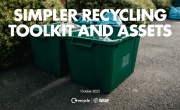An eye on the markets: Biomass market appeal
Julia Turner, Executive Director of the Wood Recyclers' Association, gives an update on the market for waste wood
Over the past five years the waste wood sector has seen unprecedented growth and far-reaching changes to legislation, guidance and processes, altering the shape of our industry as we know it.

During the next 12 months we are expecting even more change, with several large scale IED Chapter IV compliant biomass plants due to enter commercial operations in the UK, demanding in excess of an additional one million tonnes of waste wood biomass fuel per year. Given that we estimate the UK produces approximately five million tonnes of raw waste wood a year, these new plants will be a game-changer, generating sufficient industrial and commercial demand to ensure the UK no longer has to landfill waste wood, a real success.
From our own members’ survey statistics in 2017, the effect of the increasing biomass market is clearly evident: its demand rose to 1.7 million tonnes last year compared to 1.6 during 2016. This increase was offset by a fall of approximately 300,000 tonnes in waste wood exports, which was just 300,000 tonnes in 2017 compared to 600,000 in 2016. Our prediction now is that we are likely to become a net importer before very long if we are to feed the new biomass plants with the feedstock they will require.
2017 also saw a year-on-year growth of 38 per cent within the panel board sector for WRA members. Total UK panel board usage in 2017 rose to 924,000 tonnes. Further recycling routes such as landscaping, animal bedding and the equestrian surfaces markets produced an additional 800,000 tonnes during 2017, which is fantastic for the UK’s economy and environment.
 This article was taken from Issue 95
This article was taken from Issue 95All of this growth has been happening alongside tremendous change to the regulations that govern our sector. In particular, the Environment Agency’s (EA) Fire Prevention Plan (FPP) guidance and Waste Wood Classification project.
With the FPP, through many meetings, discussions, perseverance and determination on the sector’s part, we have managed to secure an open dialogue with the EA, which led to a better understanding on both sides and ultimately more flexibility within the guidance to allow bonafide operators to continue with their business. In December, we became the first material stream to publish sector
specific guidance to help wood recyclers and reprocessors gain an FPP. The guide outlines the fraction sizes of waste wood that may be stored, the difference in their storage requirements, as well as how to manage seasonality challenges and how to explain these in an FPP. A key measure of success for this project was to move away from the ‘one size fits all’ approach that the original FPP guidance contained, and obtain flexibility for waste wood operators requiring larger pile sizes and storage durations.
Crucially, the EA listened to our concerns over the guidance and has been willing to work with us to find solutions that work for operators whilst achieving the EA’s main goals of protecting the public and the environment. The fact that our sector has played such a huge role in bringing this issue to light is one we are very proud of.
We have also been working closely with the EA and other industry trade bodies to identify the real scale of hazardous waste wood in the UK waste wood stream. This is an on-going project but one which, as the lead, we have been complimented on our handling of by the EA.
It is clear that the percentage
of hazardous wood in our waste stream is currently less than 0.1 per cent, although we accept this may increase slightly as a result of the work we are currently doing. We are about to start testing samples of waste wood and will feedback the results of this in due course







